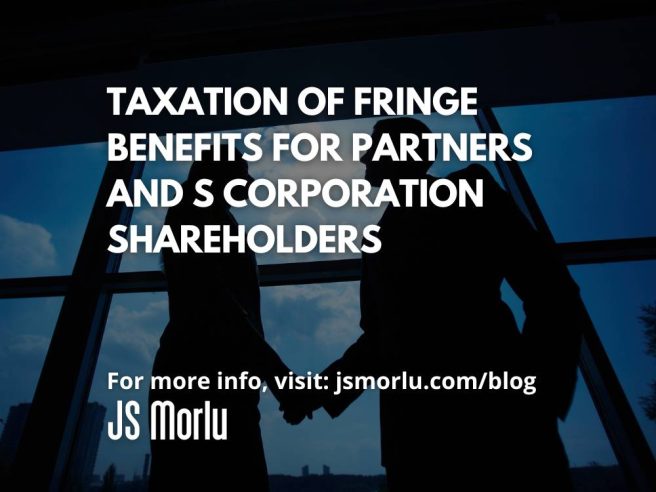By: John S. Morlu II, CPA
Understanding Fringe Benefits and Their Tax Implications
Fringe benefits are a form of compensation provided to individuals in exchange for services rendered. They can take various forms, such as health insurance, educational assistance, or employee discounts. According to the Internal Revenue Code (IRC), all forms of compensation, including fringe benefits, are taxable unless explicitly excluded by law. Section 61(a) of the IRC provides a broad definition of income, explicitly including compensation such as fees, commissions, and fringe benefits.
However, despite the inclusion of fringe benefits in the definition of gross income, many types of fringe benefits are partially or fully excluded from federal income tax withholding (FITW), as well as from Social Security (FICA) and Federal Unemployment Tax (FUTA) in specific cases. Understanding the taxability of fringe benefits for various groups, including partners and S corporation shareholders, is essential to ensure compliance with tax regulations and to maximize the benefits available.
Tax Treatment of Fringe Benefits for Employees
For taxation purposes, the term “employee” encompasses the following individuals:
- Non-owner employees of any type of entity.
- Shareholder-employees of C corporations.
- Shareholder-employees of S corporations who own no more than 2% of the corporation’s outstanding stock during the year.
Members of an LLC treated as a corporation are subject to the same fringe benefit rules as corporate shareholders. Conversely, members of an LLC taxed as a partnership are treated as partners.
Fringe benefits are excluded from taxable income if they meet specific criteria for exclusion under tax law or qualify as “working condition fringe benefits” as defined in Section 132(d) of the IRC. Certain fringe benefits may also be subject to nondiscrimination rules and limitations on exclusions.
One advantage of providing fringe benefits that qualify for exclusion is that, while the recipient does not pay taxes on the value of the benefits, the employer can deduct the expense as a business cost.
Taxation of Fringe Benefits for Partners
Partners in a partnership are not considered employees for tax purposes. Instead, they are classified as self-employed individuals. This distinction impacts the treatment of fringe benefits provided to partners.
Fringe benefits provided to partners are generally treated as guaranteed payments under Section 707(c) of the IRC. These payments are included in the partner’s gross income and are subject to self-employment tax. However, certain fringe benefits, such as health insurance premiums, may be deducted by the partnership as a business expense and reported as income on the partner’s Schedule K-1.
Taxation of Fringe Benefits for S Corporation Shareholders
The tax treatment of fringe benefits for S corporation shareholders varies based on the ownership percentage of the shareholder.
- Shareholders Owning 2% or Less
Shareholder-employees owning 2% or less of an S corporation’s stock are treated similarly to employees of C corporations. They are eligible for the same exclusions for fringe benefits as regular employees.
- Shareholders Owning More Than 2%
Shareholder-employees owning more than 2% of an S corporation’s stock are subject to different rules. These shareholders are not considered employees for fringe benefit purposes but are instead treated as self-employed individuals. As a result, certain fringe benefits, such as health insurance and group-term life insurance, must be included in their gross income. However, the S corporation can deduct the cost of these benefits as a business expense.
Common Fringe Benefits and Their Tax Treatment
The following table outlines the tax treatment of various fringe benefits for FITW, FICA, and FUTA purposes:
| Type of Fringe Benefit | FITW | SS & Medicare | FUTA |
| Accident & Health Insurance | ✓ | ✓ | ✓ |
| Achievement Awards (Tangible Property) | ✓ | ✓ | ✓ |
| Adoption Assistance | ✓ | Taxable | Taxable |
| Athletic Facilities (On Premises) | ✓ | ✓ | ✓ |
| De Minimis Benefits | ✓ | ✓ | ✓ |
| Dependent Care Assistance (Limits Apply) | ✓ | ✓ | ✓ |
| Educational Assistance (Limit: $5,250) | ✓ | ✓ | ✓ |
| Employee Discounts (Limits Apply) | ✓ | ✓ | ✓ |
| Employer-Provided Cellphones | ✓ | ✓ | ✓ |
| Group Term Life Insurance | ✓ | ✓ | ✓ |
| Health Savings Accounts | ✓ | ✓ | ✓ |
| Lodging on Business Premises | ✓ | ✓ | ✓ |
| Meals (On Premises) | ✓ | ✓ | ✓ |
| No-Additional-Cost Services | ✓ | ✓ | ✓ |
| Retirement Planning Services | ✓ | ✓ | ✓ |
| Transportation & Parking Benefits | ✓ | ✓ | ✓ |
| Working Condition Benefits | ✓ | ✓ | ✓ |
Key Notes on Specific Fringe Benefits
- Health Insurance: Health insurance premiums paid on behalf of more-than-2% S corporation shareholders are included in their gross income but are deductible on their personal income tax returns.
- Educational Assistance: Employer-provided educational assistance is excluded up to $5,250 annually.
- Transportation Benefits: The Tax Cuts and Jobs Act (TCJA) eliminated employer deductions for qualified transportation benefits but allows deductions for transportation necessary for employee safety.
Flexible Spending Arrangements and Cafeteria Plans
Certain qualified fringe benefits may be offered through flexible spending arrangements (FSAs) or cafeteria plans. These arrangements allow employees to choose between cash compensation and qualified benefits without rendering the qualified benefits taxable. Employees benefit from these plans by receiving tax-free benefits while employers gain a tax-deductible expense.
Conclusion
Understanding the tax implications of fringe benefits is essential for business owners, partners, and S corporation shareholders. Properly classifying and reporting these benefits ensures compliance with tax laws and allows businesses to maximize the value of compensation provided to their employees and stakeholders. Employers and shareholders should consult IRS publications and, if needed, seek professional advice to navigate the complexities of fringe benefit taxation effectively.
Author: John S. Morlu II, CPA
John S. Morlu II, CPA, is the CEO and Chief Strategist of JS Morlu, a globally acclaimed public accounting and management consulting powerhouse. With his visionary leadership, JS Morlu has redefined industries, pioneering cutting-edge technologies across B2B, B2C, P2P, and B2G landscapes.
The firm’s groundbreaking innovations include:
• ReckSoft (www.ReckSoft.com): AI-driven reconciliation software revolutionizing financial accuracy and efficiency.
• FinovatePro (www.FinovatePro.com): Advanced cloud accounting solutions empowering businesses to thrive in the digital age.
• Fixaars (www.fixaars.com): A global handyman platform reshaping service delivery and setting new benchmarks in convenience and reliability.
Under his strategic vision, JS Morlu continues to set the gold standard for technological excellence, efficiency, and transformative solutions.
JS Morlu LLC is a top-tier accounting firm based in Woodbridge, Virginia, with a team of highly experienced and qualified CPAs and business advisors. We are dedicated to providing comprehensive accounting, tax, and business advisory services to clients throughout the Washington, D.C. Metro Area and the surrounding regions. With over a decade of experience, we have cultivated a deep understanding of our clients’ needs and aspirations. We recognize that our clients seek more than just value-added accounting services; they seek a trusted partner who can guide them towards achieving their business goals and personal financial well-being.
Talk to us || What our clients says about us



